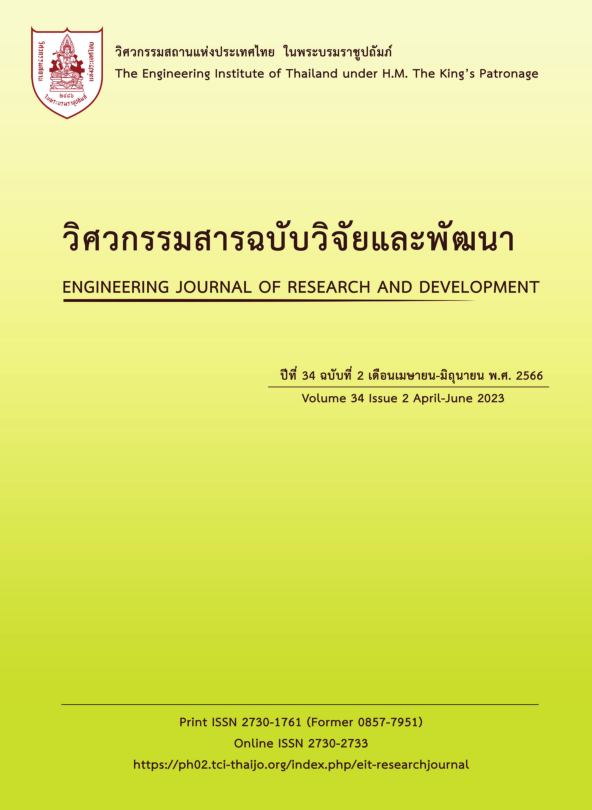A COMPARATIVE STUDY OF THE POINT-CLOUD QUALITY FROM UAV LASER SCANNING AND BLOCK-BASED IMAGES PROCESSING
Main Article Content
Abstract
Nowadays, UAV Laser scanning is increasingly being a part of surveying and mapping. The key data of this survey technology is point cloud. But the acquisition of point cloud data can also be obtained through the processing of a block of aerial images by using Structure-from-motion technique (SfM) in photogrammetric computer vision. This research aims to study of qualitative comparison of point cloud from two different survey techniques. The research study characterizes of point cloud formation and standard deviation of height differences according to the roof of buildings. Three point clouds data are used in this research, one is laser scanning point cloud data from LiDAR Swiss. The others are SfM point clouds from two different of aerial images data using different cameras and flight models, including a block of Cannon EOS 5DSR aerial images which has 60% of overlap and 30% of sidelap and a block of ZENMUSE P1 aerial images which has 80% of overlap and 60% of sidelap. By mean of cross-sectional studies of 5 large buildings it reveals that the UAV laser scanning point cloud and the SfM point cloud from ZENMUSE P1 aerial images is consistent with the roof structure of all buildings. In comparison, the cross-section of SfM point cloud from Cannon EOS 5DSR aerial images is not consistent with the roof structure of all buildings. The standard deviation of height differences in each building by using UAV laser scanning point cloud compares to SfM point cloud from ZENMUSE P1 and Cannon EOS 5DSR respectively are 0.016 m and 0.318 m for 1st building, 0.023 m and 0.545 m for 2nd building, 0.020 m and 0.695 m for 3rd building, 0.018 m and 0.609 m for 4th building and the last building are 0.019 m and 2.230 m. As a result, the UAV laser scanning point cloud and SfM point cloud from ZENMUSE P1 have more accuracy and quality, it can be applied in building modeling as well as being used to generate a 3D map.
Article Details

This work is licensed under a Creative Commons Attribution-NonCommercial-NoDerivatives 4.0 International License.
The published articles are copyright of the Engineering Journal of Research and Development, The Engineering Institute of Thailand Under H.M. The King's Patronage (EIT).
References
Srirattanapaisarn, T. RTSD Unmanned Aerial Laser Scanner. Royal Thai Survey Department Journal, 2020. pp. 12-28.
Xiong, B., S. Oude Elberink, and G. Vosselman, Building Model From Noisy Photogrammetric Point Clouds. ISPRS Technical Commission III Symposium, 2014. Volume II-3, 2014.
Do, P.N.B. et al. A Review of Stereo-Photogrammetry Method for 3-D reconstruction in Computer Vision. 19th International Symposium on Communications and Information Technologies (ISCIT), 2019.
Schönberger, J.L., F. Fraundorfer, and J.M. Frahm. Structure-from-motion for MAV image sequence analysis with photogrammetric applications. The International Archives of the Photogrammetry, Remote Sensing and Spatial Information Sciences, 2014. pp. 305-312.
Hyeon Jeong, J. et al. Dense Thermal 3D Point Cloud Generation of Building Envelope by Drone-based Photogrammetry. Journal of the Korean Society of Surveying, Geodesy, Photogrammetry and Cartography, 2021.
Hillen, F. Optimization of LiDAR data line of sight analysis in service-oriented architectures using the OGC Web Processing Service, in The Geoinformatics course. 2011, The University of Osnabruck: Germany. pp. 83.
Santitamnont, P. Digital photogrammetry. Bangkok. 2021.
Glira, P. Hybrid Orientation of LiDAR Point Clouds and Aerial Images, in Department of Geodesy and Geoinformation.
TU Wien: Austria, 2018.
Strecha, C. The rayCloud–a vision beyond the point cloud. 2014.
ESRI. What is lidar data?. Available from: https://desktop.arcgis.com/en/arcmap/latest/manage-data/las-dataset/what-is-lidar-data-.htm
Bannakulpiphat, T. et al. Best practice for Mapping Production from UAV Imagery. Engineering Journal of Research and Development, 2023, 34 (1).
Laoniphon, C. et al. Performance Assessments of Correction Models in GNSS Network-based RTK Positioning. 18th International Conference on Electrical Engineering/Electronics, Computer, Telecommunications and Information Technology (ECTI-CON), 2021. pp.2-5
Bannakulpiphat, T. et al. A Case Study Of Multi-Head Camera Systems On UAV For The Generation Of High-Quality 3D Mapping. Engineering Journal of Research and Development, 2022, 33 (4).
Ye, N. et al. Accurate and dense point cloud generation for industrial Measurement via target-free photogrammetry. Optics and Lasers in Engineering, 2021, 140.


